Tove Jansson made a name for herself not only with the Moomins, but also with large public murals and works from the 1940s onwards. The subjects Jansson used in her monumental works for public spaces were often an escape from the harsh realities and misery of war - the works were intended not only to tell a story but also to entertain and cheer.
Tove Jansson’s monumental works include frescoes and murals for public buildings, which reflect her ability to create large, spatial compositions. These works represent her ability to combine the details of everyday and fantasy life into large-scale spatial solutions. His works convey a strong sense of humanity and warmth and remain an important part of the Finnish artistic heritage. All the works in this article will be presented in different ways in the Tove Jansson – Paradise exhibition at the Helsinki Art Museum HAM, open from 25 October 2024 to 6 April 2025.
Painted window decorations at the Tullinpuomi restaurant, 1941
The painted window decorations in the Tullinpuomi Restaurant were the first works Tove Jansson ever made for public spaces. The paintings at the entrance and lift doors of the restaurant on Mannerheimintie in Helsinki were completed in 1941. Some of the glass and paintings were shattered in the bombing of 1944 and again years later. Tove Jansson restored these to their original condition with minor alterations.

The rare and unique works were thought to have disappeared during a renovation of the restaurant in the 1980s, but in 2024 it was discovered that the paintings had been rescued by the building’s caretaker at the time from a lorry on its way to the dumping ground. Jansson’s works of cultural and historical importance were auctioned in the spring of 2024.
Painted window decorations at the Apollonkatu Girls’ School, 1943-1944
Tove Jansson’s decoration of public spaces continued after the stained glass windows of the Tullinpuomi Restaurant in Helsinki’s Apollonkatu Girls’ School. The four window frames, painted in 1943, were executed by Jansson by painting in gouache colours on parchment paper, which was attached to the window.
The stained-glass windows were commissioned by Jansson’s mother Signe Hammarsten Jansson’s friend Karin Allardt Ekelund, then headmistress of the girls’ school. Jansson was only paid for the cost of the materials for the first work, but pleased with the four window frames, the headmistress commissioned Jansson to paint a second work. The water-themed view of paradise in the circular window of the dining hall, the Wellspring of Life, was completed in 1944 and Tove Jansson was also paid a commission. A copy of Tove Jansson’s original work is on display in the current Minervaskolan.
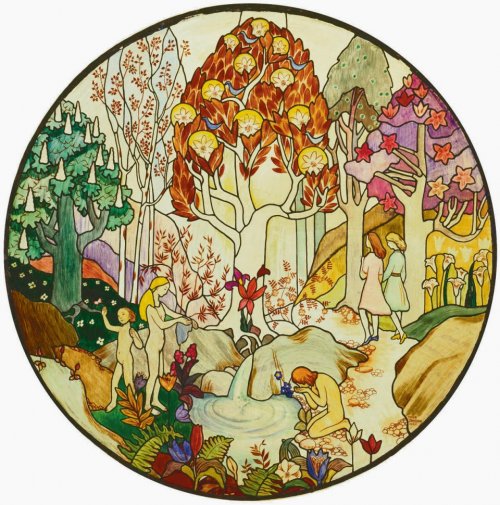
Electricity & Resting after work, 1945
Tove Jansson received the first major commission of her career from the electromechanical company Oy Strömberg Ab in 1945 – a fresco for the factory’s canteen in Pitäjänmäki, Helsinki.

Through her work, Tove hoped to help workers relax and painted a depiction of a moment of rest. However, the commissioner wanted something to do with the factory, so Tove created a second work, Electricity, for the space.
The murals Electricity and Resting after Work in the canteen of Strömberg’s Pitäjänmäki factory were completed in 1945.

The works removed from the factory in the 1960s are on display at the Helsinki Art Museum HAM in the exhibition Tove Jansson – Paradise from 25.10.2024 to 6.4.2025.
Party in the City & Party in the Countryside, 1947
In 1947, the City of Helsinki commissioned Tove Jansson to paint two large murals for the City Hall of Helsinki in the Kaupunginkellari restaurant. While painting the frescoes Party in the Countryside and Party in the City in 1947, there was indeed cause for celebration – the war was over and there was once again freedom to party and dance.
It took Tove Jansson six months to complete the two large murals, an incredible feat for a young artist. Before the actual painting, Jansson worked out 1:1 sketches on cardboard, which were approved by the architect and the city council. For the Party in the Countryside, Jansson was assisted by fellow student Niilo Suihko, but the Party in the City she did independently, although Suihko is mentioned in both paintings.
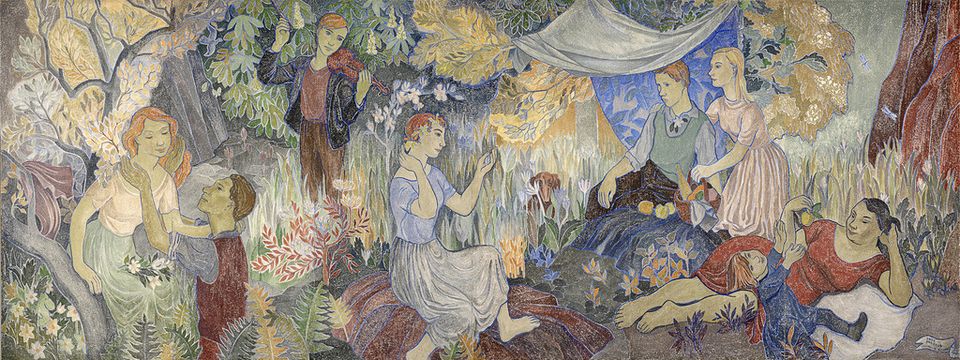
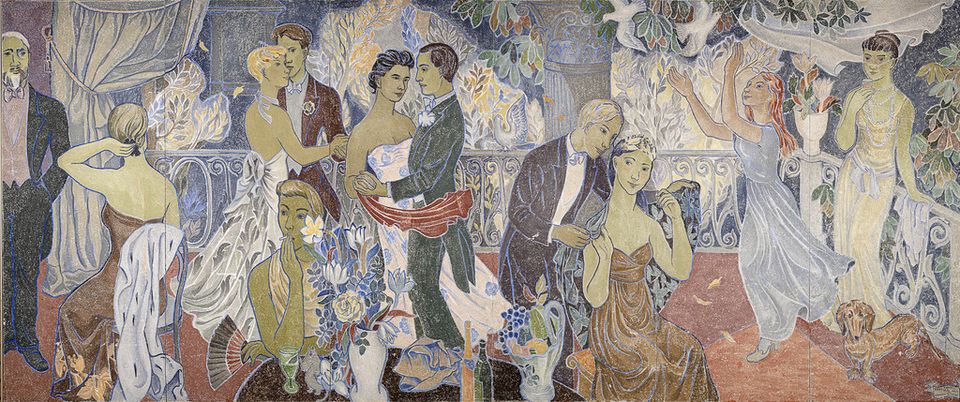
The commissioner, Erik von Frenckell, the financial director of Helsinki and father of Tove’s former lover and friend Vivica Bandler, asked for Moomintrolls for both paintings. After these frescoes, Moomin figures began to appear occasionally in other paintings in Tove’s public spaces. Jansson has also immortalised herself smoking in the foreground of a painting of a party in the city. Behind the table, Vivica Bandler dances in a rose-patterned dress.
Both Johannes Gebhard, a teacher at Ateneum, and Tove Jansson’s father, the sculptor Viktor Jansson, are said to have instructed Tove to make the frescoes in shallow metal boxes so that they could be removed from the wall and moved if necessary. In 1974, the frescoes were moved from their original location to Arbis, the Swedish-language Workers’ School in Helsinki.
In 2014, the art museum Ateneum borrowed the works for its Tove Jansson exhibition and Arbis received high quality copies of them. In 2015, after a thorough restoration, the original works were permanently moved to museum premises at the Helsinki Art Museum HAM to ensure that they remain in good condition.
The works are currently on display at the HAM and a special spotlight will be shone on these and other public artworks in the Tove Jansson – Paradise exhibition from 25 October 2024 to 6 April 2025. More information about the works is also available in the exhibition’s comprehensive catalogue, which can be purchased at the exhibition itself.
Fairytale Panorama for private kindergarten, 1949
In the 1940s and 50s, Finland commissioned plenty of large works of art for public spaces, as art was seen as playing an important role in rebuilding a wounded nation that had just experienced two wars. Thanks to her talent, ambition and the good relations of her artistic family, Tove Jansson received many commissions for murals, all over the country.
In 1949, Jansson created two fairytale panoramas for the private nursery of the Kotka Federations Stevedoring company. Rich in fairytale themes and Moomin characters, the full-wall murals were painted by Tove using the fresco-secco technique, with lime paints directly on the drywall. In addition, stones and pieces of glass were sprinkled on top of the paintings for decoration. According to the local newspaper, the rider in the second painting would be Tove herself.
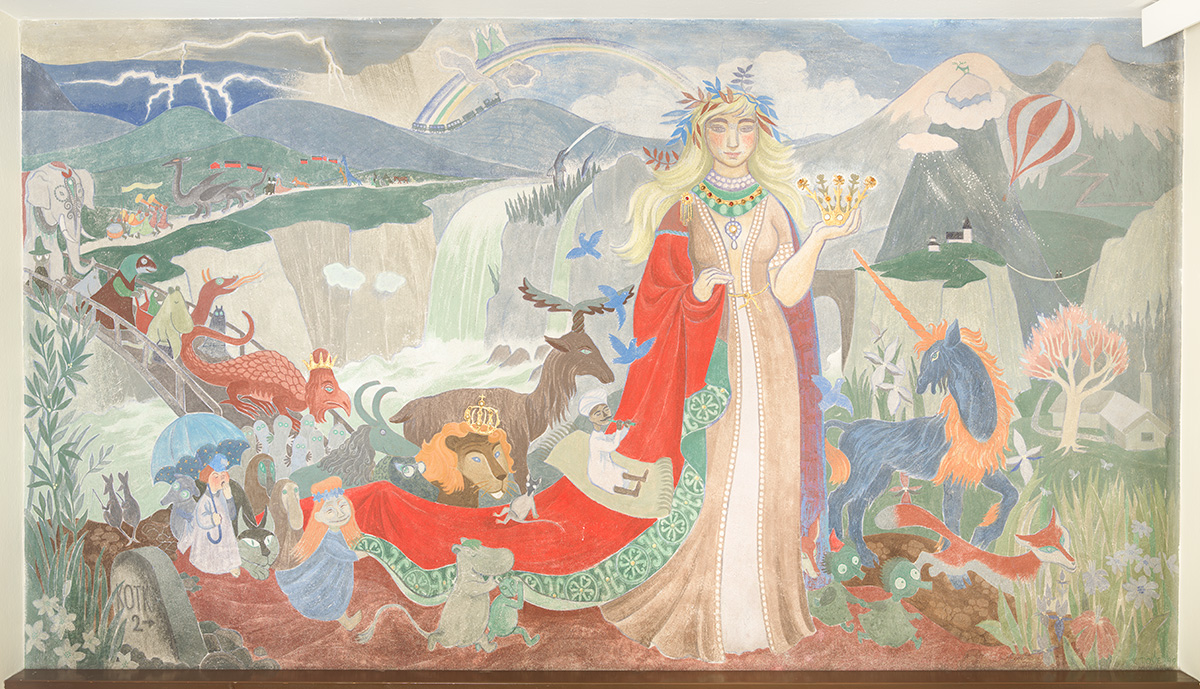
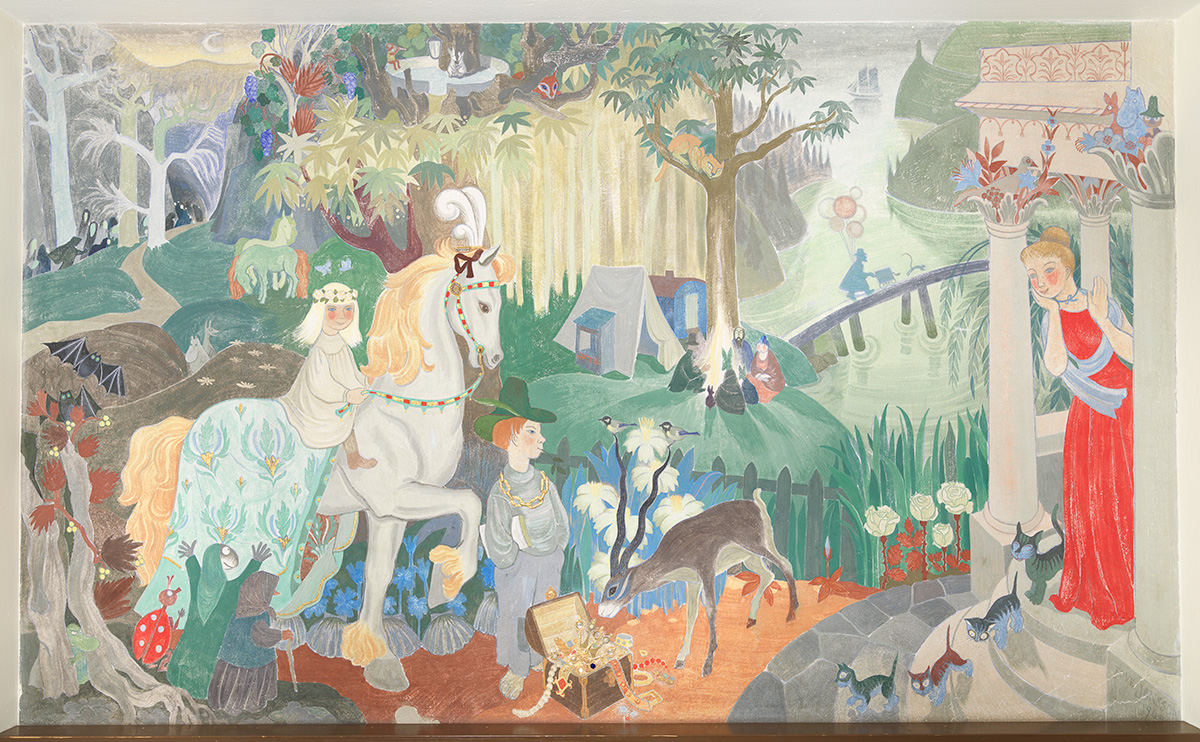
The premises in Kymenlaaksonkatu are now home to the City of Kotka’s Early Childhood Education Administration, and the works are not on public display.
Kotka Maritime school’s mural, 1952

A few years after the Kotka nursery paintings, in 1952, Tove also painted a mural in the current Ekami canteen in Kotka. The subject of the painting, a seafarer, a lighthouse and a mermaid, shows how it was made for the maritime school of the time.
The painting on the wall of the canteen has suffered over the years, for example because of the canteen chairs and splatter from food. The plaster has come loose from the work in several places, and there are rumours that the Moomin figure in the work may have ‘fallen off the wall’ at some point due to damage to the lower part. However, when the original 1:1 sketch scrolls of Tove Jansson were opened in 2023, it was confirmed that the work was one of those in which Jansson had not included a Moomin figure.
Murals for the city of Hamina, 1952
The City of Hamina commissioned the work from Tove Jansson for its 300th anniversary celebrations in 1953. The mural The Story from the Bottom of the Sea was painted in 1952 for the cabin of the Seurahuone hotel in Hamina, depicting the sea. Another painting from the same year depicts the history of Hamina.


1:1 sketches of Tove Jansson’s works have survived for decades, and these drawings are on display in the exhibition Tove Jansson – Paradise, showcasing the techniques Jansson used.
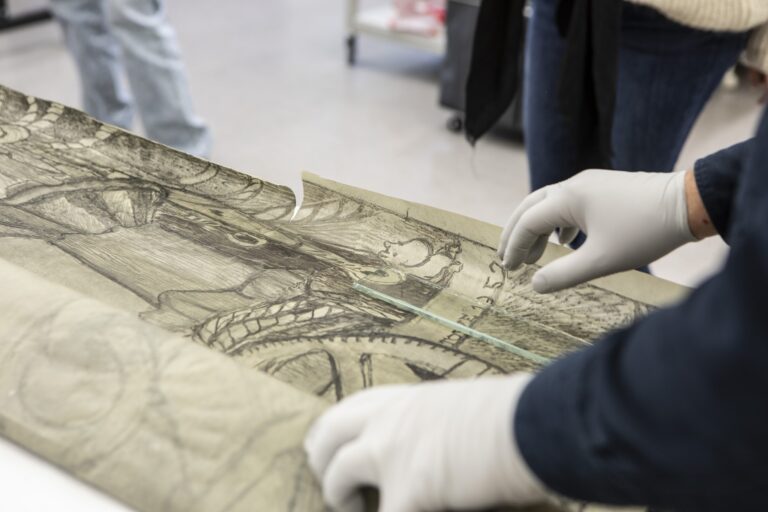
Domus Academica paintings, 1952-1953
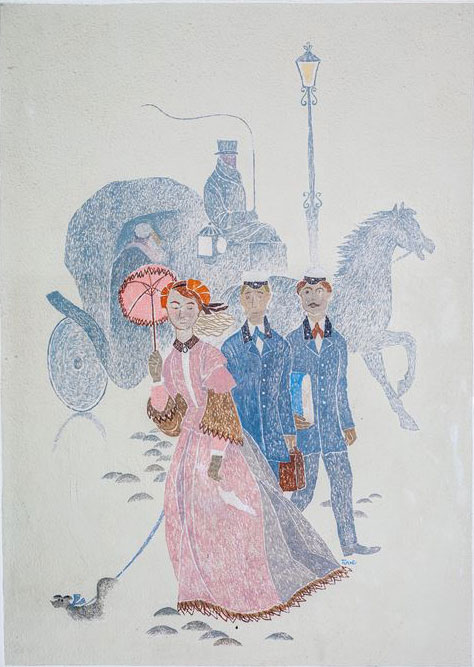
Between 1952 and 1953, Tove Jansson painted murals in the Domus Academica student residence in Helsinki and decorated the lift doors in the lower lobby. Tove Jansson lived in the building in the 1940s and left her mark on the walls. The well-known Ilmari Tapiovaara also worked in the building at one time, creating a Domus chair especially for the premises. The summer hostel, which later became Hostel Domus Academica, rebranded itself in spring 2019 and now operates as Both Helsinki Hostel.
Bird Blue, 1953
Tove Jansson’s fresco-secco mural Bird Blue in the large dining room of Karjaa Community School, was completed in 1953. Read art historian Solveig Eriksson’s story about the mural below the picture.
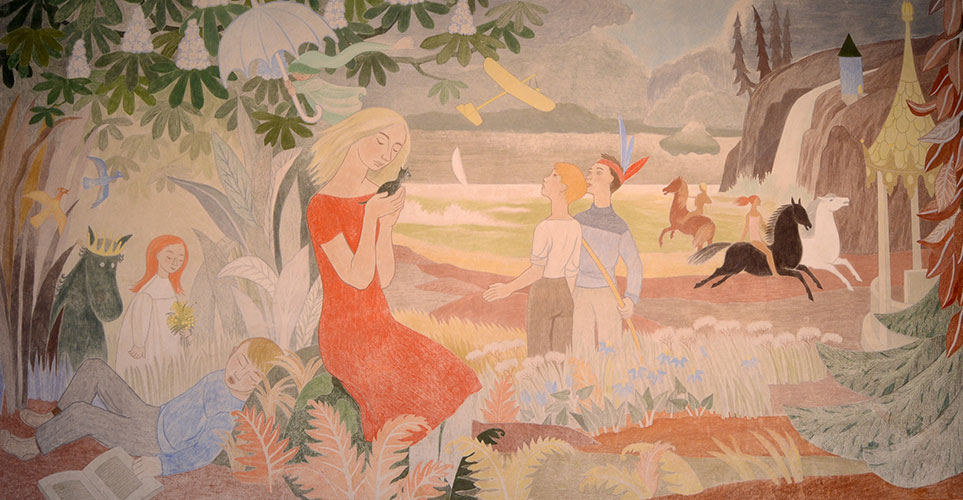
Read the full story in Finnish or Swedish here.
In Karjaa, Tove Jansson was commissioned by the Karjaa Trade Centre to decorate the dining hall of the then Swedish-language primary school in Kiila, a building designed by Hilding Ekelund. The mural, 190 cm high and 360 cm wide, covers most of the southern back wall of the dining room and is done directly on the wall using the secco technique. Jansson has used around forty shades of colour to create the mural. The colours of the mural are brilliant and varied, almost every detail differs in colour, yet the overall effect is harmonious and balanced, almost dreamlike and idyllic.
The artist lived in the office during his work, had his own bed there and ate in the school canteen with the pupils. Rainer Holmström, the school’s architect, told a newspaper article that the pupils had followed the painting work with a watchful eye, even to the point of distraction. They hung in the courtyard in the iron bars of the dining room windows, blocking daylight from entering the dining room.
The artist wanted to make her painting in such a way that the schoolchildren themselves could look for details in the picture that would appeal to them. The same work could therefore be interpreted in many different ways, depending on the child. There is no predetermined fairy tale or story, the painting only provides references and imagination with the building blocks to create their own narrative. The artist has simply depicted subjects that fascinated her as a child: a cat, a horse, a tower, the sea and a waterfall. Through complex references, Jansson has skilfully woven elements from many children’s fairy tales into her painting. On the left, from the forest canopy, fly two birds, yellow and blue, hence the name of the entire mural, Bird Blue. Bird Blue is also a children’s fairy tale written by Zacharias Topelius. The bird also often appears in art as a symbol of freedom and imagination.
On 31 October 1953, Tove Jansson had told a journalist from Västra-Nyland the following about the subject of the painting, when he had asked the artist whether the boy who had fallen asleep by the stone had been in a homework chapter, to which Tove had replied: ‘Everyone has the right to sleep by what is unpleasant!’ The artist’s humorous, humane attitude is well illustrated by this statement! The artist said of the Moomintroll on the left: “The Moomintroll in the painting is very shy, that’s why it hides among the vegetation. The troll always changes colour depending on his mood. He is not very intelligent or talented, but he is a very kind and very nice troll.”
The painting Bird Blue will also be displayed at the Tove Jansson – Paradise exhibition in Helsinki, although the work itself, painted directly on the wall, will not be shown. Using sketches and photographs of the mural, the work will be presented in the exhibition with a video showing how a charcoal sketch is transformed into a final colour painting.
The Ten Virgins, 1953

Elsi Borg, the architect of Teuva Church, commissioned Tove Jansson to design the altarpiece for the church. Tove painted the five-metre wide altarpiece directly on the wall of the church under construction in the summer of 1953, after sketching and preparing the work throughout the spring. The mural depicts the parable of the five wise virgins and five foolish virgins in the Gospel of Matthew. The altarpiece The Ten Virgins is the only altarpiece Tove painted in her career.
Jansson created numerous sketches for this fresco-secco painting. The final 1:1 sketches on sketch paper, preserved for posterity, show how the outline was perforated. According to Jansson’s own workbook notes, after perforation the sketch was placed on the wall and, by tapping with a cloth bag filled with charcoal, the outline was drawn on the wall through the holes. Jansson had already used this method in her earlier work, for example, Bird Blue.
In 2024 the altarpiece featured the opera Tove Teuvalla. In addition to the opera, a documentary film Tove Jansson and the Ten Virgins, produced by Moomin Characters, was made and can be seen in the exhibition Tove Jansson – Paradise at the Helsinki Art Museum HAM. The documentary film gives a new perspective on the small rural village of Teuva and on Tove Jansson as an artist. The film features researchers’ observations and contemporaries’ memories of Jansson and altar painting, and delves into Jansson’s thoughts on different painting techniques through workbook entries and letters.
In addition to Tove Jansson’s personal letters and notes, the documentary features a wealth of archival material, including unprecedented film footage shot by Tove Jansson’s life partner Tuulikki Pietilä. Tove Jansson is voiced by actress Alma Pöysti and narrated by Alma’s brother, actor Oskar Pöysti.
Teuva Church is still in use and you can see the altarpiece during your church visit.
Fantasy, 1954
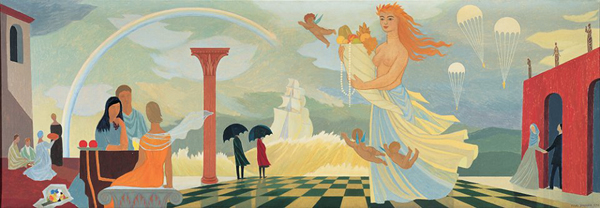
Fantasy, a painting by Tove Jansson for the dining room of the head office of the Pohjoismaiden Yhdyspankki in Finland, was completed in June 1954. The three-metre-long tempera painting on canvas of the goddess of fortune is part of the collection of the Nordea Art Foundation and is no longer in its original location. The work and its sketches are on display in the exhibition Tove Jansson – Paradise until 6 April 2025 at the Helsinki Art Museum HAM.
Play I-III, 1955-1956
During 1955-1956, Tove Jansson painted Moomins running up the stairs on the walls of the staircase of the children’s outpatient clinic of the Aurora Hospital in Helsinki. The idea behind the works, called Play, was to get children excited about watching the Moomins at play and possibly forget that they were at the hospital.

The paintings for the children’s hospital in Aurora are among the few that Jansson obtained for herself through an art competition. The paintings feature a group of familiar Moomin characters hurrying up the stairs painted on the wall: Moominmamma and Moominpappa, the Fillyjonk carrying a gift box and, for example, a fluffy-haired child riding a roly-poly fairy horse. Looking at the works, it is clear that Jansson fulfilled the competition’s brief:
The painting in the stairwell should capture the imagination of young patients and distract them from the stress of arriving in a hospital. The mural should entice them up the stairs, making them curious to discover what images might be waiting further up, thus transporting them to the second floor without them even noticing.
In the course of the Polyclinic’s activities, an estimated one million children and their escorts were able to admire the work in the Aurora Hospital. The Aurora children’s wards were transferred to the Children’s Hospital in 1997 and in 1998 Kari Petäjä and Maija Poskiparta made a copy of Jansson’s original work for the staircase of the Children’s Hospital with the donated funds.
After the completion of the new Moomin-themed New Children’s Hospital in 2018, renovation work began on the former Children’s Hospital. After the renovation, copies of Jansson’s original work are still be seen on the premises, now called a Park Hospital (for adult surgery).
The original sketches of the Play murals are on display again in the exhibition Tove Jansson – Paradise until 6 April 2025.
Fairytale paintings in the Hobgoblin’s Hat kindergarten, 1984
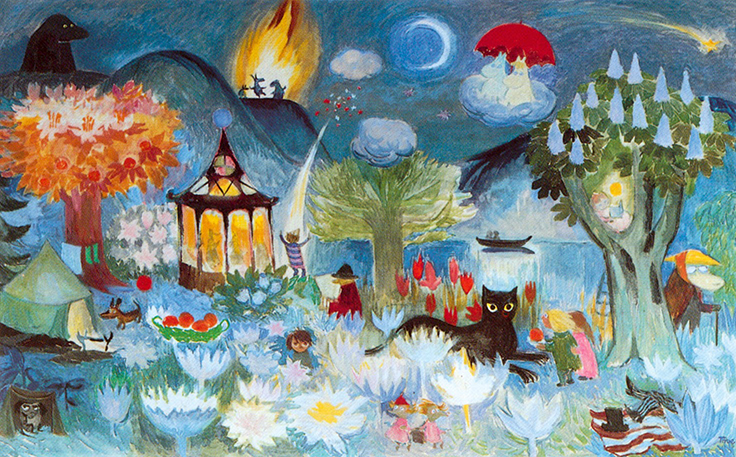
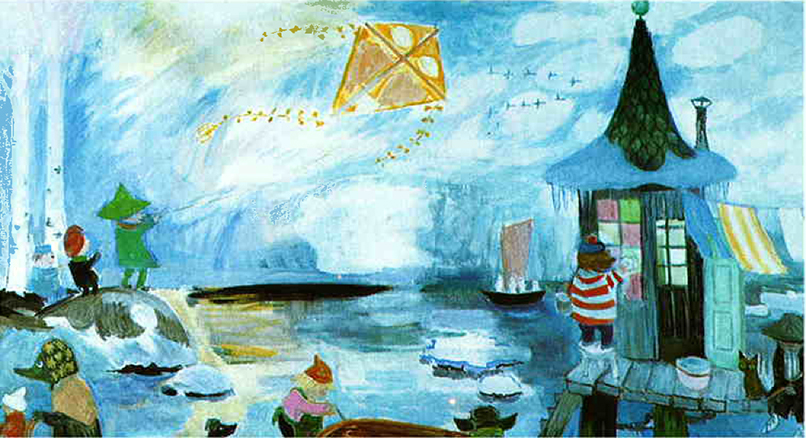

In 1984, 70-year-old Tove Jansson painted her last monumental work in the ballroom of the Hobgoblin’s Hat Kkindergarten in Pori. The three-part mural depicts the Moomins adventuring through spring, summer and autumn in Moominvalley.
The Hobgoblin’s Hat nursery is a building designed by Tove’s life partner Tuulikki Pietilä’s brother and his wife, architects Reima and Raili Pietilä, the name of the kindergarten also refers to Tove’s book Finn Family Moomintroll, which in Swedish is called Trollkarlens hatt (“the Hobgoblin’s Hat”).
Tove Jansson’s monumental paintings show her skill in dealing with large surfaces and space while creating intimate and detailed images. Although her reputation, particularly for the Moomin books, was based on the world of fairytales, these large, public frescoes reveal her wider ability to depict both everyday life and major social themes. For Tove Jansson, colour was very important and she worked hard to achieve a balance in her paintings, even when the subject matter was complex.
Through her monumental works, Jansson left a lasting mark on Finnish public art, and in them one can see a combination of architectural precision, emotional narrative and symbolism that connects people at different stages of life and in different eras.
